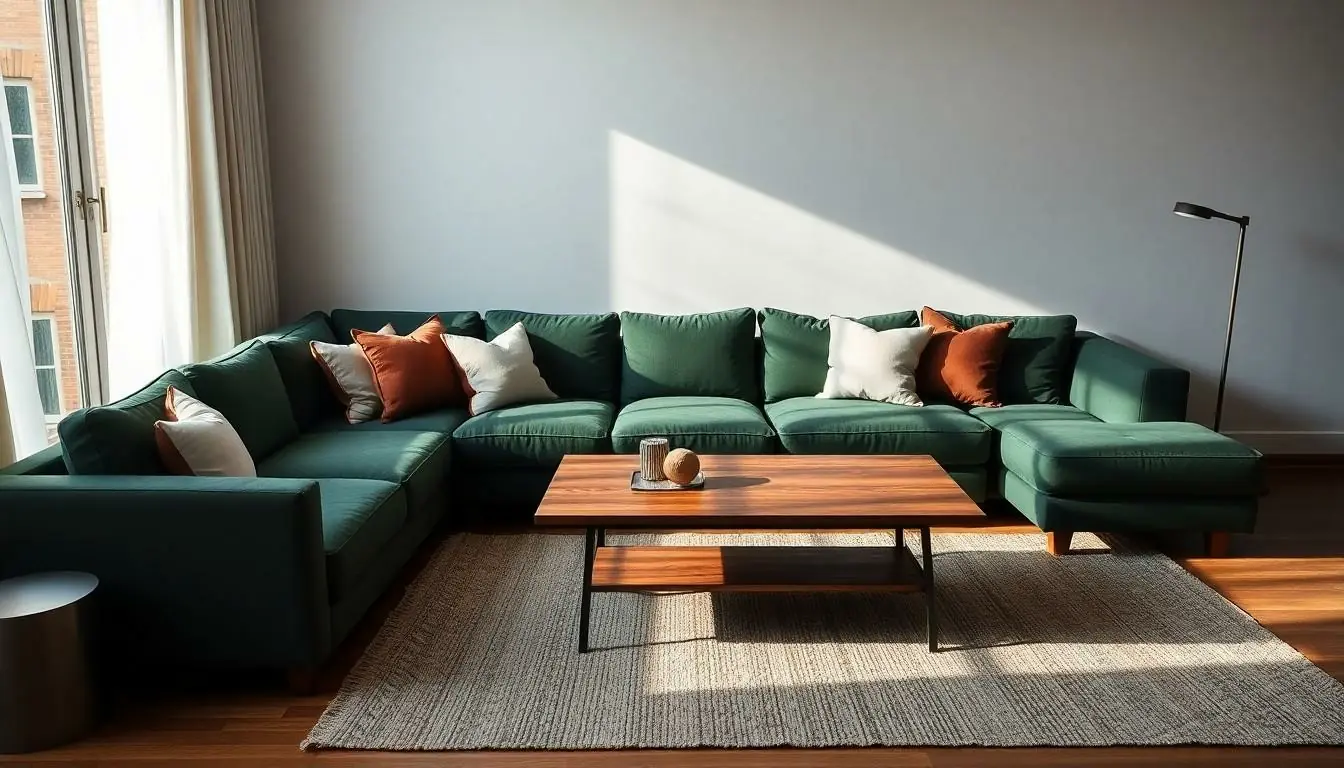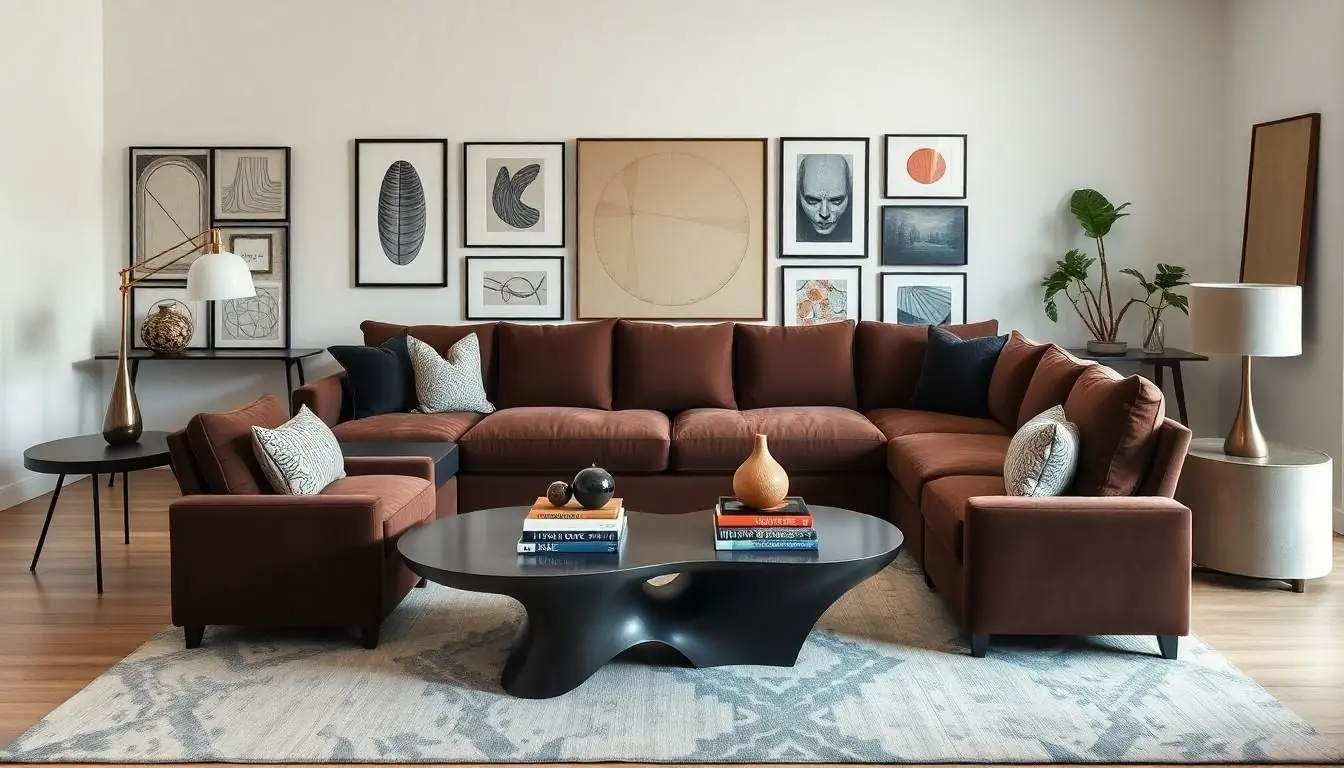Asymmetrical balance in interior design might sound like a fancy term reserved for art critics and high-end decorators, but it’s actually the secret sauce to creating spaces that feel both dynamic and inviting. Imagine walking into a room that feels effortlessly stylish, where every element seems to play off each other without trying too hard. That’s the magic of asymmetry—it’s like a well-executed dance where no partner steals the spotlight.
Table of Contents
ToggleUnderstanding Asymmetrical Balance
Asymmetrical balance in interior design creates visual harmony through unequal yet complementary arrangements of elements. This approach allows for creativity, resulting in spaces that feel inviting and alive.
Definition of Asymmetrical Balance
Asymmetrical balance refers to a composition where different visual weights are distributed unevenly but still achieve equilibrium. For example, placing a large sofa opposite a collection of smaller decorative items can create an engaging focal point. In this way, asymmetrical arrangements encourage movement and flow without rigid symmetry.
Importance in Interior Design
Asymmetrical balance enhances the beauty and functionality of spaces. It attracts attention and fosters an inviting atmosphere. Designers often use it to create unique focal points that captivate viewers. Incorporating varied shapes, sizes, and colors builds depth and fosters visual interest. This balance ultimately leads to a more dynamic environment, promoting a sense of individuality.
Elements That Contribute to Asymmetrical Balance

Asymmetrical balance in interior design relies on various elements that create dynamic visual arrangements. Understanding these components enhances the overall harmony of a space.
Color and Texture
Color plays a crucial role in achieving asymmetrical balance. High-contrast colors draw attention and create focal points, while soft hues produce a soothing backdrop. Designers often combine matte and glossy finishes to enhance depth. Textures also contribute significantly; rough surfaces juxtaposed with sleek fabrics can create intriguing interactions. Layering textiles, like a plush rug paired with smooth wooden furniture, adds richness to the design. All elements must work together, ensuring that each piece complements others without overwhelming the space.
Shapes and Proportions
Shapes and proportions are vital in establishing asymmetrical balance. Different shapes, like geometric and organic forms, provide variety and interest. Large, statement furniture can balance with smaller accessories placed strategically. Proportions must be considered carefully; a tall lamp next to a low side table creates visual contrast and maintains equilibrium. Combining various dimensions fosters an engaging layout. Each selected shape leads to a unique composition that emphasizes individuality throughout the room. Achieving this balance enables spaces to feel both harmonious and inviting.
Techniques for Achieving Asymmetrical Balance
Asymmetrical balance enriches interior design through intentional techniques. Designers achieve this balance by focusing on various elements that contribute to a harmonious space.
Strategic Placement of Furniture
Furniture arrangement plays a pivotal role in achieving asymmetrical balance. By positioning a large sofa across from smaller accent chairs, for example, visual weight distributes evenly yet intriguingly. Placing a coffee table off-center creates an engaging conversation area while adding depth. Additional seating, like a unique pouf or ottoman, can further enhance the layout, inviting exploration. Each piece complements others in size and shape, forming a cohesive look that feels inviting. This thoughtful placement encourages flow and movement, enhancing the room’s overall atmosphere.
Layering Decor Items
Layering decor items cultivates visual interest and charm. Stacking books with decorative trays atop a console table exemplifies this technique, balancing height and texture. Incorporating items of various sizes, like sculptures or plant arrangements, attracts the eye across the space. Grouping artworks in an asymmetrical gallery wall engages viewers and adds character. Odd numbers of decor pieces often create more dynamic arrangements, allowing creativity to shine. These layers enrich the environment and provide inviting focal points throughout the room.
Examples of Asymmetrical Balance in Interior Design
Asymmetrical balance manifests uniquely in both residential and commercial spaces, showcasing creativity through unequal arrangements that create harmony.
Residential Spaces
In residential spaces, asymmetrical balance often appears through furniture arrangement. A large sectional couch might anchor a living room, while smaller accent chairs provide balance without mirroring. Decorative elements like floor lamps or artwork create focal points by countering larger pieces, enhancing visual interest. Using various colors, textures, and shapes fosters a dynamic feel. For instance, a vibrant rug anchors a seating area, while minimalist side tables offer contrast. This variety in design not only amplifies style but also encourages individual expression, making spaces feel more personalized and inviting.
Commercial Spaces
Commercial spaces benefit greatly from asymmetrical balance, contributing to brand identity and customer experience. A café may feature a long communal table offset by smaller tables and chairs, creating a welcoming environment. Wall art displayed in a staggered layout draws attention and engages patrons. Mixing materials, such as wood with metal accents, infuses character and warmth. In retail environments, strategically placing displays allows products to shine without clutter. This approach captures attention while ensuring a cohesive atmosphere, encouraging interaction and exploration. By thoughtfully balancing elements, commercial spaces invite customers to spend more time and connect with the brand.
Asymmetrical balance in interior design is a powerful tool that transforms spaces into dynamic and inviting environments. By thoughtfully arranging elements of varying sizes shapes and colors designers can create visual interest and harmony. This approach not only enhances aesthetic appeal but also encourages individuality and creativity in both residential and commercial settings.
Embracing asymmetry allows for unique focal points and a flow that invites exploration. It’s a design philosophy that celebrates the beauty of contrast and encourages a sense of connection. Ultimately asymmetrical balance is about creating spaces that feel alive and engaging drawing people in and making them feel at home.




